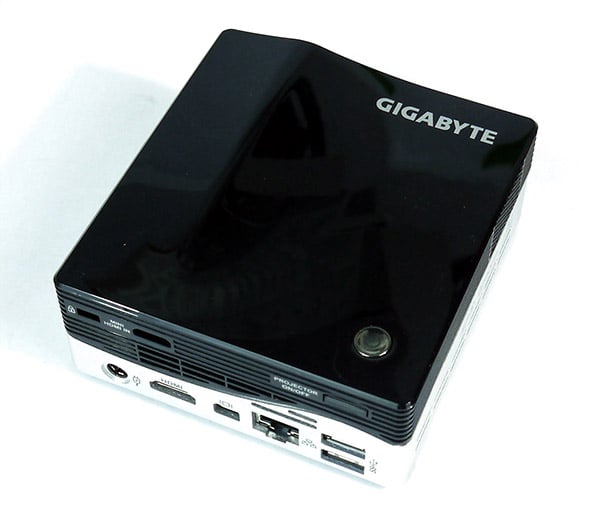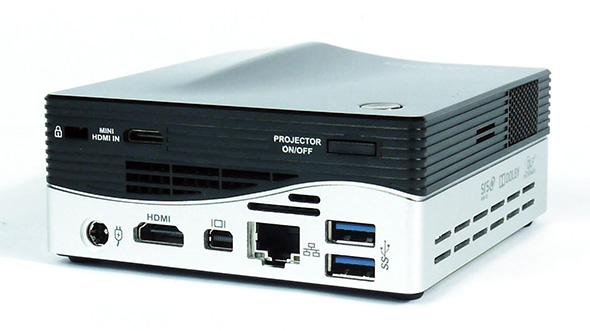Gigabyte Brix PC/Projector Review
Design & Functionality
The Brix Projector, being a NUC form factor device, is tiny. As a PC, that means you can stash it anywhere you need it to be, and as a projector that means you can bring it with you anywhere you need it. The thing will fit just about anywhere, being just a few inches (almost) square and not even two inches tall, and because it has a built-in projector, you don’t necessarily need to be able to plug it into a monitor.
It’s hard to explain how bizarre it is, in a good way, to be able to just fire up a PC and point it at a wall to see a Windows desktop environment. Of course there are no integrated input tools on the Brix Projector, so you have to have a USB mouse and keyboard along, too.
There’s a switch that let you toggle the projector on and off, so you can use the projected image as your main display; hook it up to an external monitor; or use both as a sort of dual-monitor setup.
You can also use the projector as just a projector, which is a terrific feature. That is to say, you could hook up a DVD player, another notebook PC, or what have you and use the projector part of the device to display them.
In that sense, the Brix Projector is versatile and convenient. However, it’s not without its shortcomings.
Primarily, the display resolution for the projector itself is just 864x480, which is a nightmare if you’re using Windows 7 (which the device just happens to run). For example, if you’re installing software or even looking at a web page, the projector won’t display every part of the window. Thus, you’re left unable to see what you’re doing all too often.
When connected to an external display the issues are hardly noticeable, but we did find that connecting the Brix Projector to a smart TV still required too much fiddling with display resolution to get everything looking right.
And what of the projector itself? Gigabyte says that its projected image size is 7 inches to 85 inches, but we found that we could get a bit smaller. On the “big” side, we ran out of wall space, but the image could easily extend beyond 12 feet on the diagonal. There’s a focus ring on the side of the Brix Projector, and it glides easily enough although you’ll need a steady hand if you want to keep from jostling the image.
We noticed that the projector starts up with almost no lag, which is a nice touch. The onboard 1.5W speakers aren’t particularly impressive, but they’ll get you loud-enough audio in a quiet room if need be. The Brix Projector is a 75 lumen DLP (LED backlit) device, and it offers a 16:9 aspect ratio with a 900:1 contrast ratio.
Because this is an inexpensive mini projector that’s tacked onto a PC, we didn’t expect much in terms of quality, but the little guy is rather impressive all things considered. The image is not all that bright--you can see that even relatively dim light will wash out the picture (the projector is positioned about five feet from the wall here)--but with the lights off in a home theater room (or outside at night), the Brix Projector does just fine. The projector's black levels are decent, for what you’re paying for, as well.
You can set the Brix Projector on any flat or slightly inclined surface as you would any other projector, but Gigabyte also included a tiny tripod with adjustable, flexible legs that screws into the bottom of the unit that you can use, too. It’s a handy feature to have available, but note that it’s extremely difficult to get a completely straight picture when you’re fiddling with those legs.
Let’s dig into some benchmark tests to see how this tiny machine performs.
It’s hard to explain how bizarre it is, in a good way, to be able to just fire up a PC and point it at a wall to see a Windows desktop environment. Of course there are no integrated input tools on the Brix Projector, so you have to have a USB mouse and keyboard along, too.
There’s a switch that let you toggle the projector on and off, so you can use the projected image as your main display; hook it up to an external monitor; or use both as a sort of dual-monitor setup.
You can also use the projector as just a projector, which is a terrific feature. That is to say, you could hook up a DVD player, another notebook PC, or what have you and use the projector part of the device to display them.
In that sense, the Brix Projector is versatile and convenient. However, it’s not without its shortcomings.
Primarily, the display resolution for the projector itself is just 864x480, which is a nightmare if you’re using Windows 7 (which the device just happens to run). For example, if you’re installing software or even looking at a web page, the projector won’t display every part of the window. Thus, you’re left unable to see what you’re doing all too often.
When connected to an external display the issues are hardly noticeable, but we did find that connecting the Brix Projector to a smart TV still required too much fiddling with display resolution to get everything looking right.
And what of the projector itself? Gigabyte says that its projected image size is 7 inches to 85 inches, but we found that we could get a bit smaller. On the “big” side, we ran out of wall space, but the image could easily extend beyond 12 feet on the diagonal. There’s a focus ring on the side of the Brix Projector, and it glides easily enough although you’ll need a steady hand if you want to keep from jostling the image.
We noticed that the projector starts up with almost no lag, which is a nice touch. The onboard 1.5W speakers aren’t particularly impressive, but they’ll get you loud-enough audio in a quiet room if need be. The Brix Projector is a 75 lumen DLP (LED backlit) device, and it offers a 16:9 aspect ratio with a 900:1 contrast ratio.
Because this is an inexpensive mini projector that’s tacked onto a PC, we didn’t expect much in terms of quality, but the little guy is rather impressive all things considered. The image is not all that bright--you can see that even relatively dim light will wash out the picture (the projector is positioned about five feet from the wall here)--but with the lights off in a home theater room (or outside at night), the Brix Projector does just fine. The projector's black levels are decent, for what you’re paying for, as well.
You can set the Brix Projector on any flat or slightly inclined surface as you would any other projector, but Gigabyte also included a tiny tripod with adjustable, flexible legs that screws into the bottom of the unit that you can use, too. It’s a handy feature to have available, but note that it’s extremely difficult to get a completely straight picture when you’re fiddling with those legs.
Let’s dig into some benchmark tests to see how this tiny machine performs.
















